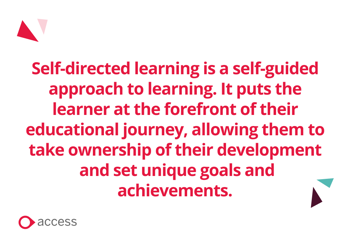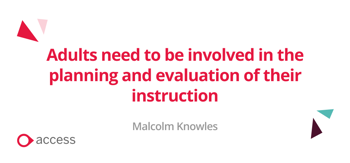What is self-directed learning, and how can it transform workplace learning?
Self-directed learning is a self-guided approach to learning which makes the most of the variety and options available to those looking for different methods of learning. With the increase in employees actively seeking out their own learning endeavours and organisations recognising the value of nurturing this culture, self-directed learning should be an integral part of every organisation's L&D strategy.
In this article, we will go into more detail on what self-directed learning is, the theory behind it, the benefits of self directed learning in the workplace and three strategies that your organisation can implement to improve uptake amongst your people.
- What is self-directed learning?
- Examples of self-directed learning in practice
- What is the theory behind self-directed learning?
- How does self-directed learning benefit employees?
- How does self-directed learning benefit managers?
- How does self-directed learning help L&D teams?
- Implementing self-directed learning in the workplace
- Overcoming challenges and barriers
- Reap the benefits of self-directed learning in the workplace with the help of Access Learning
What is self-directed learning?
Self-directed learning is a self-guided approach to learning which puts the learner at the forefront of their educational journey, allowing them to take ownership of their development and set unique goals and achievements.
Self-directed learning happens constantly in our daily lives, and it's a powerful tool that can be applied in workplace environments to help employees learn independently. While individuals are often aware of their own development needs, they might not have the right setup to meet them. That's where learning and development (L&D) professionals come in: it's their role to provide the environment, resources, and knowledge employees need to thrive.
While the responsibility is shifted to the learner, L&D teams must also support them on their journey with suitable resources and a cultural approach to this type of learning.
Employees can benefit from:
- autonomy of choice
- self-motivation
- efficient learning methods
Organisations can benefit from:
- elevated employee performance
- enhanced engagement and staff retention
- continuous learning

Examples of self-directed learning in practice
To better understand how self-directed learning can be implemented, consider these practical examples:
Bite-sized online courses
Short, focused online courses are a fantastic way to empower your team. Designed by subject matter experts, these modules allow individuals to learn at their own pace and in a style that suits them best. This approach is perfect for onboarding, compliance training, or introducing new software or processes. These courses can complement traditional training or stand alone as valuable learning resources.
Learning hubs
Imagine a central online repository where employees can access information relevant to their roles and development. Think of it as a digital library, easily accessible online. Here, your team can independently explore resources, delve into specific subjects, and find answers to their questions. A learning management system (LMS) makes creating and maintaining such a valuable resource straightforward.
Microlearning modules
Deliver key information efficiently with short, focused learning bursts. These brief lessons, often just a few minutes long, cover specific topics and are ideal for busy professionals. Consider incorporating gamification elements like rewards and progress tracking to boost engagement. Whether through short videos, interactive quizzes, or concise articles, microlearning offers a convenient way for employees to acquire new skills or reinforce existing knowledge. Find out more about how to use gamification to improve employee engagement.
Independent projects
Encourage your team to take ownership of their professional growth through independent projects. Managers can set broad objectives or identify areas for exploration, acting as facilitators and offering guidance as needed. This approach allows employees to delve into subjects that genuinely interest them, developing valuable problem-solving skills and contributing to your organisation's success.
What is the theory behind self-directed learning?
Traditional learning often takes a one-size-fits-all approach, with instructors dictating the curriculum. Self-directed learning theory flips this script, placing employees at the centre of their learning journey – but where did it come from?
Self-directed learning theory can be tracked back to the work of Malcolm Knowles, who formalised it in his 1975 book, "The Adult Learner: A Neglected Species". Knowles' theory underscores the significance of this approach, aligning with the first principle of andragogy:
"Adults need to be involved in the planning and evaluation of their instruction."
This principle recognises that adults can identify their own learning needs.
However, in a workplace setting, people can’t do this without consistent learning support. It's the responsibility of Learning and Development departments to create a learning environment that not only acknowledges this capacity but also equips employees with high-quality tools and resources to create a positive self-directed learning environment.

What are the benefits of self-directed learning for employees?
One of the top three reasons to spend more time learning in 2024, according to the LinkedIn Workplace Learning Report, is “if it is personalised for my interests and career goals.” This shows just how beneficial learning can be if it is tailored to each individual.
Let’s explore how it can help empower and develop employees in more detail:
1. Personal growth and development
A self-directed learner will take charge of their personal and professional growth. By having flexibility in learning pace and content, employees can focus on areas of interest and learn at their own speed. This fosters a sense of accomplishment and builds self confidence.
2. Supports career development
When offered a variety of different learning opportunities, employees can take initiative and identify skills and knowledge relevant to their current or desired job roles. This targeted learning demonstrates a strong commitment to growth and positions them for advancement within the company.
3. Encourages a healthy work-life balance
If an employee integrates different types of learning into their daily routine of their own volition, it empowers them to take ownership of their development. This sense of agency can lead to improved work-life balance by actively shaping their skills and knowledge, helping them become more competent and efficient, reducing work-related stress.
4. A blended learning experience
Not everybody absorbs information in the same way, so providing learners with different methods, they can find what they find the most effective. By offering a range of diverse learning materials, different learning styles and schedules can be accommodated.
5. The freedom to learn and develop
By learning anywhere at any time, employees have the freedom to learn when and how they want to. An online platform that is also available via mobile means that materials can be accessed on demand at a time that best suits the learner.
What are the benefits of self-directed learning for managers?
While self-directed learning provides a lot of advantages to employees, it’s important to look at how it can also help managers. Below are four benefits of self-directed learning in the workplace which impact management and team leaders:
Staff retention
According to the 2023 Linkedin Learning report, three of the top five factors that drive people to pursue new jobs reflect their desire to stretch, grow, and develop new skills.
These factors are:
- Doing challenging and impactful work
- Opportunities for career growth within the company
- Opportunities to learn and develop new skills.
With the demand for targeted and tailored learning chosen by the learner, it’s no surprise that self-directed learning can play a key role in this.
Increases employee engagement and ownership
By encouraging a self-directed learner to develop at their own pace, managers can increase employee engagement. Tailored learning experiences will lead to higher motivation and a happier workforce overall. It will also likely reduce staff turnover and increase retention rates.
Encourages upskilling initiatives
When an employee takes ownership of their learning, they are more likely to proactively seek out opportunities to upskill with the help of the internal resources available to them. From a management perspective, this can create a more dynamic team who strive to learn more, which can encourage internal promotions and movement.
Leverages internal resources
Self-directed learning encourages employees to explore the wealth of resources already available within the company. By utilising these internal resources, managers can save on external training costs and ensure employees are learning with materials tailored to the company's specific needs and processes.
Drives innovation and adaptability
Self-directed learning encourages employees to stay up to date with industry trends, new technologies, and best practices on their own initiative. This can result in a more innovative and adaptable workforce, better equipped to respond to changes in the market and take advantage of new opportunities.
How does self-directed learning help L&D teams?
The shift towards self-directed learning empowers both learners and L&D professionals, leading to a more effective and engaging learning environment. Here's how self-directed learning specifically benefits L&D teams:
Reduce time spent assigning and managing training
When an employee seeks out their own learning opportunities, it takes the onus off L&D managers to assign, manage and track the training. This reduction in time spent on administrative tasks allows them to focus on strategic decision-making instead.
Cultivates a learning culture in the workplace
Employees are more likely to see themselves as active participants in their own development. This fosters a culture of continuous learning within the organisation, which can help alleviate some of the demand from L&D teams to encourage this kind of behaviour, as it will be embedded through this type of learning.
Offers anonymous learning
Some employees may feel hesitant to disclose their skill gaps or learning needs in a traditional training environment. Self-directed learning platforms can offer anonymity, encouraging participation from individuals who might otherwise be reluctant to seek out development opportunities. This allows L&D teams to gain a more comprehensive understanding of the overall skill needs within the organisation.
Identifies skills gaps
By encouraging self-directed learning, L&D teams can gain insights into the skills and knowledge gaps within the organisation. Employees' choices of what to learn can provide valuable data on areas where additional training or support may be needed, helping teams tailor development programs more effectively, which in turn aids in closing the digital skills gap.
What are the essential aspects of self-directed learning?
In order for self-directed learning to be truly embedded into the culture of an organisation, there are certain factors that come into play. These come from both the learner and the organisation.
Motivation to learn
Underpinning self-directed learning should be the employee’s willingness to learn new skills and knowledge. This motivation can stem from personal interests, career goals, or a desire to improve performance. Without their drive to seek out and actively participate in learning, the process will likely fail so understanding the employee’s specific needs will help them acquire new skills and knowledge.
Autonomy and responsibility
Handing the trust over to employees who have their own workload to manage alongside career development opportunities will require work from both sides. Employees must be allowed the freedom to choose what and how they learn but they must also take responsibility for their development.
A robust self-directed learning platform
In order to support employees with their self-directed learning journey, organisations must be able to provide enough breadth and depth of resources in order to facilitate this with ease. For example, the Access self directed learning platform powered by Bookboon, offers over 6,000 resources spanning a variety of topics, formats, and languages. This solution therefore caters to a wide range of both development goals and learning styles.
Formats include:
- audiobooks
- eBooks
- online courses and learning journeys
- live virtual classrooms
Speak to one of our learning experts to find out more about self-directed learning - powered by Bookboon.
Implementing self-directed learning in the workplace
Now we have covered the benefits of self-directed learning in the workplace, let’s look at three strategies on how to implement it successfully.
1. Creating a supportive learning environment
For employees to feel motivated to carry out their own learning initiatives, organisations must be willing to support them.
This should include:
- Dedicated time to spend on self-led learning practises
- Providing access to learning resources and tools
- Encouraging peer-to-peer learning and collaboration
2. Setting clear expectations and goals
Organisations can encourage self-directed learning by helping employees define their specific objectives and link these to career aspirations.
They can do so by:
- Aligning individual learning objectives with organisational goals
- Monitoring progress and providing feedback
- Providing progression tracking tools which are readily available and easy to use
3. Promoting a culture of continuous learning
Learning in the workplace isn’t just a box-ticking exercise – it should be encouraged. Cultivating a strong learning culture involves investing in the training and development of your employees.
This involves:
- Recognising and rewarding self-directed learning efforts
- Encouraging leaders to model self-directed learning behaviour
- Motivating your workforce to embrace different learning methods and push themselves
Overcoming challenges and barriers
While Self-Directed Learning Theory can offer organisations a number of benefits, there may be challenges that are presented when it comes to implementing this way of learning. Let’s explore three barriers and how your organisation can overcome them.
Resistance to change
If your workforce has not come across self-directed learning before, it is natural that some may be resistant to the shift. You can help tackle this by:
- Addressing concerns and misconceptions
- Building a compelling case for self-directed learning
- Finding out what type of learning your employees want to do
Maintaining accountability and tracking progress
Maintaining accountability is crucial for successful self-directed learning, both for the organisation and for the individual learner. Here's how to achieve it:
- Implement effective tracking and reporting systems
- Encourage self-assessment and reflection
Utilising a robust Learning Management System which supports different learning methods.
Ensuring equity and inclusivity
While self-directed learning offers a powerful path for individual growth, it's crucial to ensure all employees have an equal opportunity to thrive in this environment. Ensure you are:
- Providing equal opportunities for all employees
- Addressing diverse learning needs and preferences with accessible content
- Having conversations with your employees about their learning preferences and making sure these needs are met
Explore our article on how to engage learners in online learning for further inspiration creating a motivating work culture.

Reap the benefits of self-directed learning in the workplace with the help of Access Learning
As we have covered within this article, Self-Directed Learning Theory is a way of working which gives the learner the opportunity to seek their own learning opportunities.
Empowering your employees through self-directed learning cultivates a culture of ownership, continuous learning, and ultimately, a more engaged and productive workforce. At Access Learning, we are passionate about helping organisations unlock the full potential of their employees.
Find out how our Self-Directed Learning solution can help you to tailor your learning to the preferences of your employees and create a workforce that takes ownership of their learning.
Explore our Self Directed training solution today!
There are many ways to find out more about Bookboon and how our engaging, learn on demand content can transform the learning culture in your business.

Speak to an expert
Chat with one of our learning experts and find out how Bookboon Professional Development training can be tailored to meet the needs of your business, regardless of size.

Schedule a live demo
Relax and let one of our learning experts showcase the capabilities of Bookboon and find out how it can help transform your organisation.

Discover more Digital Learning Solutions
Access Learning contains all the powerful tools you need to take your organisation to the next level.

